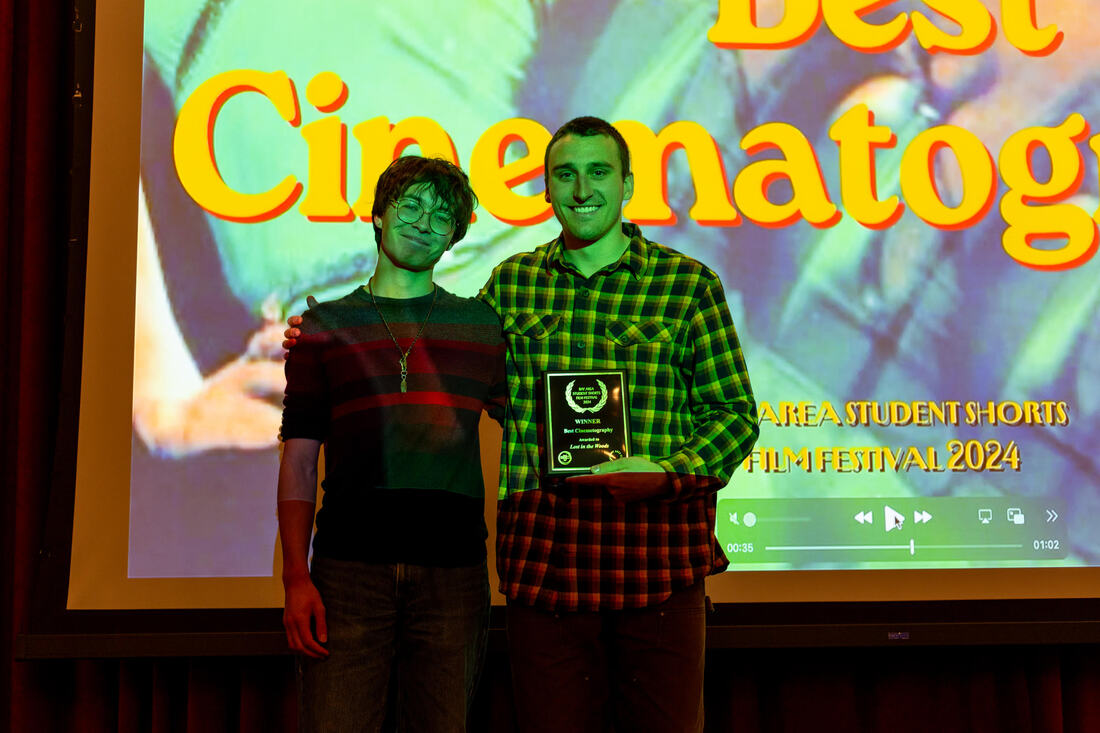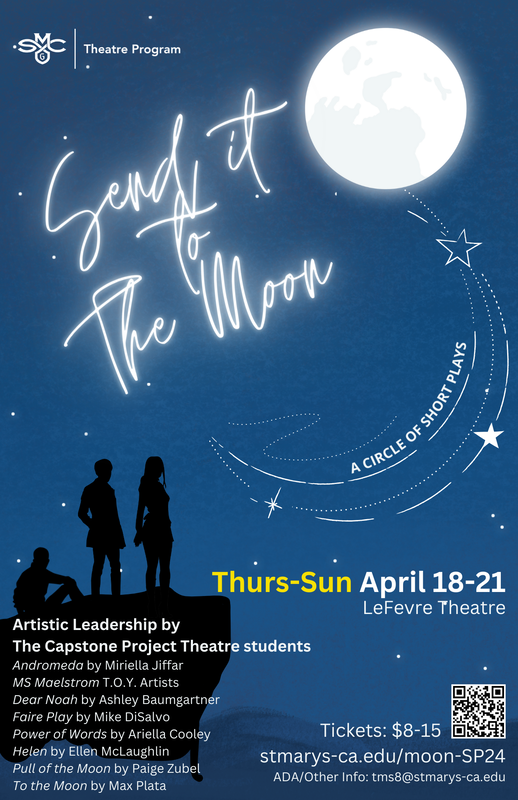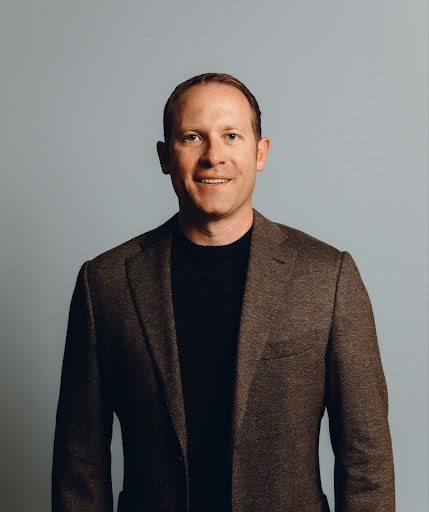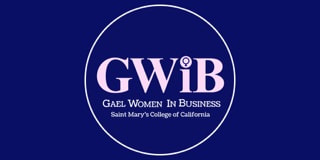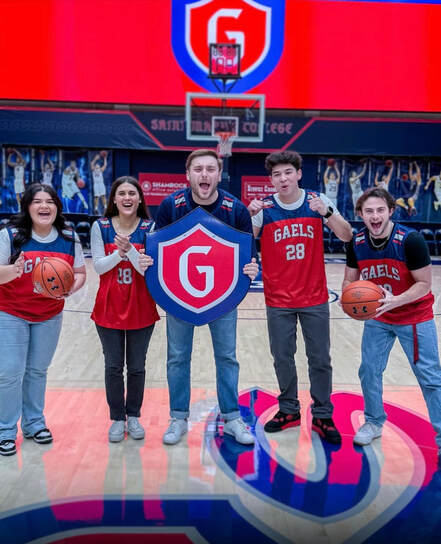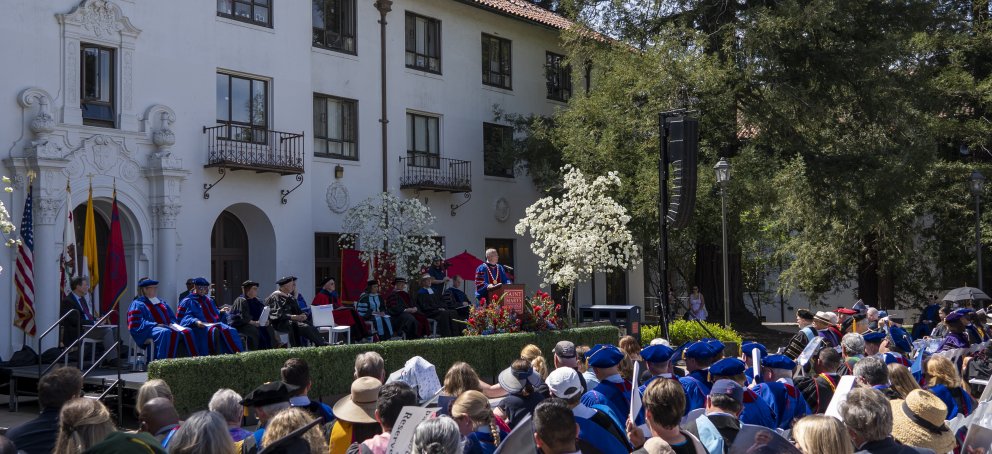|
Image c/o Bay Area Student Shorts Film Festival By Drew Paxman Visiting Columnist You may recognize Jennifer Leo’s name from her work on Pixar’s animated feature Toy Story 2. Or perhaps you are familiar with her work on Steven Spielberg’s science fiction thriller Minority Report. Maybe her work on the documentary 24 Hours on Craiglist stands out. Regardless, all of her success across these different genres stems from the first short film she produced as a student at San Francisco State.
“Short films are a calling card,” Leo addressed the audience of eager filmmakers and enthusiasts as Keynote Speaker for the 2024 Bay Area Student Shorts Film Festival (BASS). “[They are a] great way for you to get attention and for you to get jobs.” Leo’s speech opened a night of community and celebration for high school and college student filmmakers that gathered in the Soda Center at Saint Mary’s College of California on April 13. Out of a pool of over 100 film submissions, 11 were selected to be presented at the festival. From those 11 films, five were selected for individual awards in six separate categories. John Angelo Serrano, a student at California College of the Arts and the director behind “Best Animated” winner Pips Delivery felt disappointed that he had to wait until after his first year of college to create a film. Inspired by his own commute to campus, he began animating right away. “I felt like it was kind of whimsical in a way that I am traveling so much just to have a three hour class,” he said. Festival Coordinator Megan Young was ecstatic when Pips Delivery won “Best Animation.” “It was so adorable,” she remarked. Lost in the Woods was another big winner, taking home the “Best Cinematography” prize. The documentary film tells the story of Patrick Barnes, a dancer who “gave up a traditional career in dance to perform for people living on the margins of society.” “Lost in the Woods was amazing,” said Young. “It was beautifully shot, the story and the narrative were amazing and flowed so well. The two directors put so much effort into it and it really does show on the screen.” BASS Programming Coordinator Olivia Watkin gave some love to another animated film, Meghan G. Graham’s Roadkill Jamboree. “There’s no words to describe what she did,” explained Watkin. “Every person I’ve talked to has been…gobsmacked…it’s stop motion animation, it’s special effects, it’s a synthesis of all these different techniques.” BASS has been showcasing student films since 2018, when Saint Mary’s Communications student Kasey James decided to create the festival as a part of her capstone project. Young and Watkin have organized the last two film festivals. “The day after BASS last year, we met to start the planning for this year. We’ve been planning this for 365 days,” Young claimed. The pair had a vision: to expand upon the original “theater-screening style” event by making it semi-formal and including “catered dinner, guest speakers, coffee trucks, awards, plaques. Everything that you can imagine that would hopefully be at the Oscars,” Young described. This year’s festival coincided with the news of a new major coming to Saint Mary’s in the fall–Media Production, a degree conceptualized by Communications professor and documentary filmmaker Jason Jakaitis. The major, as described by Watkin, is “built to double major, built to be a minor, built to be an opportunity for on-campus leadership roles.” As for the future, BASS will continue to highlight student filmmakers from around the Bay Area long after the graduation of seniors Young and Watkin. “I think what’s next for BASS is whatever the community wants,” said Watkin. “And I think that’s the best way to have it. I think that’s the only way it becomes sustainable, I think that’s the only way it really becomes part of the [Saint Mary’s] community.” As both BASS and these student filmmakers continue to grow, Leo’s advice remains profound: “Everything takes a decade. Be patient and enjoy each little step along the way because you will get to where you want to go.” Students interested in planning the 2025 Bay Area Student Shorts Film Festival can follow bayareastudentshorts and filmclub_smc on Instagram, or can contact Jakaitis.
0 Comments
Image c/o SMC Performing Arts By Andrew Martinez Cabrera Associate Editor Starting on April 18, Saint Mary’s Theatre Department premieres their 2024 spring production, Sent it to the Moon: A Circle of Short Plays. Led by theatre’s capstone class of 2024 in a nearly year-long process of development, this team of students, including help from non-capstone students, have worked to bring to life a series of eight short plays. These plays are either adaptations of existing one-act productions or original productions written specifically for Send It To The Moon.
The involved capstone students played varying roles in the production as they were either part of the cast ensembles for each play, directing/writing the production, or involved in the technical aspects of the spring production, with positions such as set designer, stage manager, or props designer. In a letter sent out to faculty members, students, and patrons, theatre professor Shannon R. Davis described the excitement of watching the capstone leadership produce the show, “They have procured a show like artistic producers; part whimsy, part drama, part darkness, part light–the moon is the inspiration that informs the work. In their artistry, they’ve been building towards this for years, and now they are ready to share their craft and skill with you. I’m so excited for the collective vision they’ve created.” Whereas last year’s show Willow & Houston’s centered around leaving college, Send It The Moon’s motif relates to the moon, as well as themes of, “water, circles, and second chances,” written in promotional material. These motifs carry thematic resonance in each of the eight plays, while also informing things such as the set design. Each play has a distinct aesthetic working for it, positioned in different and unique temporal spaces, ranging from “Merchant sailors in a Poe story, to Helen of Troy, to a modern woman vying for a part in a renaissance faire play,” as written in their official website’s description. It’s akin to last year’s fall theatre production of A Midsummer’s Night Dream, borrowing from multiple aesthetics and not subscribing to solely one visual look. Send It To The Moon goes one step further and ties it to its variety of different narratives, each possessing its own unique flair thematically and artistically, connected via the thru line of the moon and the various other motifs. In a promotional video, senior capstone student Emma Ledesema, starring in Helen and directing Pull of the Moon, said “we want people to just come to the theatre and feel like the theatre can represent them.” Tickets for Send It To The Moon can be found on the box office page of Saint Mary’s performing arts website. The shows run from April 18 until April 21 for five performances. Image c/o Bandak Project Management By Lillian La Salle Associate Editor Nik Bandak, CEO and Founder of Bandak Project Management, is a Saint Mary’s alum who studied Finance in the Business School’s Honors Finance Program. After graduating from Saint Mary’s College in 2008, Nik began his career during the Great Recession by working for a concrete subcontractor in the Bay Area. He credits Saint Mary's and their alumni network for connecting him with employment through a fellow alum.
Bandak later moved to the Middle East where he worked for an internationally-recognized firm, Bechtel. After returning from his time in the Middle East, he was exposed to all things real estate, master planning, and construction while working as one of Betchel’s first employees in the construction management division. After 10 years of working with the firm in San Diego, Bandak leveraged his expertise in the science and technology sectors with hopes to scale his consulting business into a larger project management company. This dream has grown into his current company, Bandak Project Management. In this interview, he shares some of his tried and true advice, life and career experiences stemming from his time at Saint Mary's, and his dedication to implementing a mission-driven mindset in all areas of his life. How would you describe the makeup of the Bandak Management Project? Bandak Project Management is a tried-and-true third-party Owner’s Representative project and construction management firm headquartered in San Diego. Construction management is a complicated, multi-faceted process. To narrow it down, in real estate, there's a segment where you're getting the financing to build a project: buying land, or leasing space. Then there's the development side, which is your architects, engineers, permitting, contracting, etc. Then, there's the occupancy. This includes the chair you're sitting in, the furniture, the desk, the signage; everything you need to make the facility run. Bandak PM is the blend between the idea, how to make the idea work, and ultimately how to execute the idea all the way through occupancy. Can you give us an example of how this would look if you were developing a new Saint Mary’s building? We begin by asking ourselves, “How do we make the idea work, and then how do we execute the idea all the way through occupancy?” So, for example, Saint Mary's College might call me and say that they want a new building, such as dorms or an additional student gym. We then explain how long it will roughly take, how much it will cost, outline the approval process, and the strategy of how we will successfully deliver the project. Bandak PM provides the roadmap to the whole process from start to finish; we are the “North Star” in the sense that we point you in the direction, then guide you to accomplish your goal. In this case, Bandak PM would be guiding Saint Mary’s to get students in their housing, fans and athletes to a gym, etc. What was the most helpful thing Saint Mary’s taught you during your time here? How to do what I do, but ethically, with a mission in mind. There are multiple ways to execute a project, but there are really only so many ways to execute a project ethically and with a mission in mind. So I would say, thinking back, there's quite a bit that goes into combining financial integrity with personal integrity to execute and treat people correctly throughout the entire process. This is something Saint Mary’s definitely helped me foster in myself: the belief that dedication to an ethical missionserves the broader community. What were some of your favorite memories at Saint Mary’s? My favorite Saint Mary’s memory has to be meeting my wife. She played volleyball while I played baseball. Now we have three young children, all boys. We're coming back to Saint Mary's actually in a couple of weeks for the Gonzaga game, so we're excited about that. If you could go back to 2004-2008, what is a piece of advice you would have given to your younger self? I would tell my freshman self that everything's going to be okay; don't take life so seriously at that point in time. I think that's really important. For both first-year and fourth-year students, my advice is that it's so important to be humble and have empathy. Always maintain perspective and appreciate your bold ideas. You might graduate with a vision of what your life will look like, but meet someone only to have that vision change for the better. Who you are today will evolve. While some people join the working world and achieve everything they ever wanted to achieve, it’s important to be steady and maintain your focus. Learning how to focus is a big theme on our team. If you're going to commit to something, commit yourself wholly. I would also advise having an amazing intensity behind your passions so that you don't waver when things get a little difficult. Truly exercise that commitment and focus so you can pursue whatever your definition of happiness might be, whether it's getting married, starting a family, or founding a business. Whatever it be, commit to it, understand what your purpose is, and go for it. If you could leave us with one last thought, what would it be? It's okay if things change. You come into your 20’s having an idea of what you want to be when you grow up, but by the time you're 30, you might meet someone or have an experience that changes your focus in life and that's okay. Hopefully, when you're 60+ years old and you have reset your goals and your purpose, you've always been happy throughout the process. I think it’s really important for you to continue to be mindful and stay present throughout your life. Image c/o Gael Women in Business By Madison Sciba Editor-in-Chief Aimed towards women who are studying business, Gael Women in Business (GWiB) is a student organization targeted towards helping Saint Mary’s students prepare for success in the world of business. The goal of GWiB is to encourage and promote the skills that would be helpful for their members to not only be successful academically but also in their future professions.
“We want to create a club where they can find a community of other women within the school and they can form connections with other female students,” said VP of marketing Amanda Carter ’24. To prepare women for a future in the business world, Carter explains that Gael Women in Business holds “events that help students work on their personal and professional development.” These kinds of events include LinkedIn workshops, free professional headshots, a real estate panel, and a women in tech panel. In addition to professional development events, GWiB also puts on other less professional oriented activities that promote team bonding amongst members. Most recently, GWiB hosted a Galentine’s Day meeting where students could make flower bouquets and enjoy a variety of snacks. Events to keep an eye out for the rest of the semester include: a Target recruitment event, a “Freshening Your Pitch” workshop, and a “de-stress” event. Anyone of any major is welcome to attend an event to learn/develop skills that will later benefit them in the professional world. For more information you can contact GWiB at: Instagram: @gaelwomeninbusiness LinkedIn: Gael Women in Business - Saint Mary's College of California Remind Chat: text @gwib2024 to 81010 Email address: gaelwomeninbusiness@gmail.com Image c/o @smcgaels on Instagram By Isabella Wynn Visiting Columnist Basketball season is in full swing and the Gael’s are gearing up for some of the most exciting games of the season. Our spirited Gael Force executives are looking forward to a jam-packed semester. In asking Gael Force President Stefano Costa and Treasurer RJ Dore some questions, I gained some insight on the inner workings of Gael Force and what students can expect from this semester’s sporting events.
Stefano and RJ are both very passionate about school spirit and sports. RJ shared with me that he enjoys how being a Gael Force executive “provides a challenge” while Stefano simply enjoys getting “people excited about sporting events on campus.” Both of them, along with the rest of their team, put in a lot of work to plan events. From tailgates to watch parties, Gael Force represents Saint Mary’s passion for competitive sports. Being in the student section at basketball games is electric. Stefano and RJ both shared that their favorite cheer is “easily the ‘Aussie Aussie Aussie, Oi Oi Oi,’ which [is done] when one of our players from Australia hits a 3-pointer or has a dunk.” Stefano recognizes that other students also love this cheer, saying, “it's one that I think the whole arena loves to do…the whole [crowd] was doing it the other day when Ducas hit that half-court buzzer-beater.” SMC’s energy is high this season and we can thank Gael Force for keeping Saint Mary’s spirited culture alive. Some people might be wondering how they can become a part of Gael Force. Stefano and RJ shared two different ways students can become part of Gael Force. First, every Saint Mary’s student is eligible to “sign up using the link in [their] Instagram bio, @smc_gaelforce and [students] pay a one-time fee that covers [them] for all [school] years” (Stefano Costa). Unfortunately, Saint Mary’s will be saying goodbye to many Gael Force executives this year as many of their members are graduating seniors. However, that fortunately means that a second way students can get involved with Gael Force is applying to be an executive. Each year signups and interviews are held for executive positions on Gael Force. RJ stated that he and his fellow seniors want to leave Gael Force in “good hands with people that will put in the work to try and bring this community of students together.” If you're passionate about sports at Saint Marys and school spirit, keep an eye out for these future opportunities. This Gael Force Exec Team wants to leave behind a legacy. In doing so, they hope that future Saint Mary’s students will be just as spirited as they are. However, being on Gael Force is not simply an easy, fun job. I asked both Stefano and RJ to rate the average SMC student section and provide any advice they have to give regarding attendance and behavior at sporting events. Stefano rated our student sections a 10/10, stating that especially during tougher WCC competition “the crowd gets into it and you can feel the bleachers shaking.” RJ on the other had was a bit of a tougher rater, giving SMC a 7/10. He shared that “there is always room for improvement. If you go to a game [Gael Force] almost expects you to be loud and be a part of the crowd instead of just sitting there. We want everyone to be excited about Saint Mary’s sports and it brings down the spirit when not everyone is involved.” Gael Force is not only responsible for leading the energy of the student section but they are also responsible for the behavior of students. As our spirit leaders they want students “to be as loud as possible and to have fun, but without going too overboard” (RJ Dore). It is important to remember to “play it cool and trust the team playing is gonna get the job done no matter what” (Stefano Costa). The student section can't control what is going on on the court or the field–we simply need to commit to bringing great, competitive energy to games and being good sports at the same time. So what does Gael Force have in store for us next? Fortunately, here are some hints as to what we can look forward to this semester. Some of you might remember Gerald the Party Giraffe, RJ shared with me that “there have been talks about him making an appearance. If the people want Gerald out there, I think we can bring him out of hiatus for the end of the year and even the postseason.” If the masses want Gerald, Gael Force might just give us that. Stefano also mentioned that “this year we are bussing 50 students out to Las Vegas for the WCC tournament which is something we haven't done in a long time; it'll be good to support the team all the way out there.” In addition to a potential Gerald appearance and a Las Vegas trip this spring, we also have the highly anticipated SMC vs. Gonzaga Men’s Basketball game coming up. The boys didn't want to give too much away, however you all should know that they will be hosting a tailgate in the 1928 Pub and Dryden Hall to look forward to on March 2nd. Stefano also hinted towards some “signature drinks inspired by some fan-favorite players.” The Gael’s have won home games vs. Gonzaga the past two years and odds are looking good again this year. Our boys took home a win against Gonzaga in Spokane on February 3rd and “it's on us to help out the team come away with a W to end the season” (RJ Dore). It’s been a great year so far Gaels, let’s keep bringing the energy for the rest of the spring semester to help our teams close out their seasons successfully. Get excited. Get ready. Remember to have fun, cheer loud, and represent Saint Mary’s the best you can. Go Gaels! By Derik Eaquinto American Journalism Student The Moraga Public Library recently reopened after a number of indoor cosmetic renovations were completed. The library compliments the larger Lafayette Public Library, and both are part of the Contra Costa County Library system. Students at Saint Mary’s are eligible for a free membership as local residents, however currently, many students use the Saint Mary’s library exclusively.
The Moraga library includes a second hand nonprofit book shop, Friends of the Moraga Library, where the library website explains that donated books are sold for a fraction of retail price. Proceeds from the shop are used to provide the library with books, magazines, DVDs, furniture, and other necessities. “It's a great system to have. The shop provides another option for people looking to add to their personal collections, and the money supports the library's other free services” said one library volunteer. Residents of Contra Costa County are eligible for a free library card, giving them access to any library services within the system. “The library systems are connected. A book checked out in Moraga can be returned to Lafayette, and vice versa… For students who live off campus, this gives them a chance to explore the Moraga Library whenever they are near Saint Mary’s, and take books back anywhere they like” explained another worker. “The fiction section at the Saint Mary’s library isn’t great, but I had not considered getting a membership to the Moraga Library,” said one student. A library card could help supplement book choices and options for Saint Mary’s students. Increased use of kindles and other e readers have cut down sales and usage of paper books in recent years. “I do a lot of audio books, so I don’t see the point in getting a library card,” said another Saint Mary’s student. “A library card also gets you free access to a huge number of ebooks and audio books from the Libby App” explained a library volunteer. The Moraga Library hours and services can be found on their website. Image c/o Baile Folklórico Guadalupano By Andrew Martinez Cabrera Entertainment Editor On the night of October 27, a bustling scene unfolded in the Soda Center. The strumming of guitars and the occasional horn rung throughout the crowded room via large speakers. The only sounds louder than the music were voices, laughter, and the scurrying of feet as they tried to reach their seats. Spanish and English filled the air and mixed into a song of warmth as the audience enjoyed one another's company. At the front of the stage was a multi-stepped altar, representing heaven, earth, and the underworld – with many offrendas (offerings) to remember those who have passed, such as cempasúchil (flowers of the dead), photographs, colorful serape blankets, food and drinks, and many other trinkets.
This was the prelude to the special annual event presented by Saint Mary’s very own Baile Folklórico Guadalupano (BFG) in conjunction with SMC Dance Company: 2023’s Día De Los Muertos Dance Concert. Accompanying BFG this year were two other dance groups: Ballet Folklórico Costa de Oro from San Leandro & Grupo Folklórico Sueño Mío from Hayward. Before the dancing began, Brother Michael S. Avila, F.S.C, introduced the event, reading a written speech in Spanish and then in English. Baile Folklórico Guadalupano was started by then-second-year SMC student Yadira Guerrero in 2012, in which Br. Avila served as the first advisor. He reminisced that he was touched by the fact that, “she was not only promoting the Latino culture [at Saint Mary’s but was also] recruiting dancers from all traditions,” something which still runs true in its current rendition. As a Latino, I found not only myself immersed in my culture being celebrated and displayed by people who look and spoke like me, but also by those who come from different backgrounds – either the dancers who were a part of BFG or the students who came to watch and cheer on their friends. If the night was to be encapsulated by one word, it would be “celebration.” Throughout the course of the show, many people would shout – gritos – like mariachis would do, a familial sound that warmed my heart. The concert was composed of different sections of dances, titled after different states from Mexico, presumably composed of different types of baile folklórico. It is hard to accurately describe the sights I saw because I would fail to do justice to the spectacle of it all – the marching of women carrying prop rifles, men brandishing machetes and incorporating into their dance, dancers demonstrating such fluidity with their movements, their faces glowing; enjoying the scenery, the company, the spirit. It was a non-judgemental, transcending sight. Everyone was there to have fun. Having something like this at Saint Mary’s and having it be organized by students nonetheless is something that should be seen by all. It was a reminder of how much I love my identity. If you have not had the opportunity to witness any BFG events, do yourself the favor and check out any of their upcoming events, such as Feel Good Friday on Dec. 1 and BFG Night on Dec. 4. A recording of the event can be found on SMC Performing Arts’ Vimeo page. In an article published on the SMC website, the new Presidential Search committee was announced. Image c/o Saint Mary's College By Sarah Bagdon American Journalism student On October 23rd, Saint Mary’s announced their new Presidential Search Committee along with their Presidential Search website. This announcement has been yet another part of Saint Mary’s Transformation 2028 strategic plan. Brother David Caretti and David Perry, the two co-chairs of the committee say in their article on the Saint Mary’s website, “With the Transformation 2028 strategic plan and our Lasallian Core Principles acting as our guideposts, we are committed to working closely with members of the search committee, the Board of Trustees, our executive search firm, WittKieffer, and all members of the Saint Mary’s campus community to help find our next president.” According to Brother David, “Everyone on the search needs a holistic view of the college so they could see across departments.” He also explained, “The role of the committee is often mistaken, they do not directly hire the President, they are empowered to facilitate the search and to make sure that people are engaged. We wanted people who connected with multiple constituencies of the community.” However, there are many students who are unaware of what the President’s job is, like junior Lucy Bikhai who said, “I would love to know what the school president even does, I genuinely want to know what a person in this position does.”
Brother David said in an interview that when the committee was announced, there was a schoolwide email sent with a survey that would allow the committee to know what to look for in creating the Presidential Leadership Profiles for the candidates that are to be announced sometime within the next week. He explained, “There's been intentional engagement for people to be a part of this process.” In an interview with Provost Corey Cook, he told me, “Generally here, I think we do well when we listen to student voices. Our students are very direct, very wise, very kind…My experience is every time we invite students to give feedback, it’s helpful, constructive. I would say that every time students give input, that input is going to matter.” Most students are not aware of how impactful their voices are. Gavin Voskamp, a junior here at Saint Mary’s, explained, “On one hand I think it's great that they let students have a role in selecting or at least seeing which president is selected. I'm not sure how much of an active role we as the student body play but I think it is great that they are attempting to hear our feedback.” But according to both Brother David and Provost Cook, the students’ voices impact the school more than they know. The biggest question that is posed through the release of this new search committee is what does everyone want to see out of the next Saint Mary’s president? There were a few members on the committee that were contacted but they had both declined going on the record, due to signing a non-disclosure agreement. However, several others had some thoughts on the matter. Provost Cook said, “I work very closely with the president and I’m excited to see how it turns out. I want to find somebody who understands our mission. Somebody who can help build external relationships. External reputation of the college. A president who’s able to uncover the wonderful things our students do. Somebody who can talk about our students’ achievements and success. Talk to folks about what makes SMC special…A president excited to engage with students.” Voskamp said, “As a student I would love to see a president who is active and involved with student affairs, not just showing up to the basketball games. I mean I want them to really hear and listen to the students.” Bikhai had simply said, “I guess the biggest thing that I would want is some transparency.” However, out of every interview, Professor Denise Witzig, a Professor of Women's and Gender Studies, had the most to say. Much like the Provost, she said, “We want somebody who is engaged in the community and who has a clear idea of who we are as a community.” She especially emphasized this idea of hiring a President who is engaged with the Saint Mary’s community. “I think there are a lot of directions in which we can go, but I do think the next President has to be a people person and get to know the students and the faculty and staff…You have to listen to people, there are a lot of good ideas here on campus that are not being listened to,” she said. Something else that she had emphasized was the fact that the President needs to ask themself, “What do we want to be known for in the future? It would be good to find someone who knows about that…You want someone who will take us in bold, new directions, who honors the culture of SMC.” The biggest thing to Professor Witzig is that, “The President has to represent the college in a lot of different constituencies…All of these are different and it's important for the president to understand that and to say that this is who we are…The president of the college is a big promoter of college interests, but they have to weigh those interests with the needs of the college…someone who wants to uplift the school.” Weighing in all these issues is going to be very important for the search committee to consider when considering the candidates. As for the student body and faculty and staff, it will be important to welcome whoever is inaugurated on our campus grounds. Brother David said, “We’ve really appreciated the response of people across campus, we appreciate their interest. We know that whoever this next president is going to be, that it will be important for us to welcome them and to include them in our community just like we do everyone else and to help them feel like this is their home just like everybody else on this campus.” Ever since the influx of layoffs back in the spring, the job economy has taken a hit. College students everywhere, especially at Saint Mary’s College, are worried about what this could mean about applying for jobs come graduation in spring. By Francesca Caronna American Journalism Student We all know someone, whether that's a family member, friend or parent who was affected by the lay offs this year. In the spring, tech companies laid off thousands of employees and went into a hiring freeze (Deadline). Companies like Meta, Docusign, Salesforce and Adobe with headquarters in San Francisco act as a funnel for local college students for entry level jobs in tech. Since the hiring freeze, it has sent soon-to-be-graduating college students into a panic. According to CNN, we are experiencing the lowest level of open jobs in the past few years, and there are no predictions as to when the job market will return to normal.
This is a problem all over the country right now, but Saint Mary’s College seniors are especially worried about the potential effects the hiring freeze will have on their job search in the spring. It is a common process for seniors to start applying for jobs late winter or early spring to have something lined up after they graduate. This will start in a few short months, and senior Radha Rai stated, “I keep hearing that there are no jobs, I’m really concerned for what this will mean for me.” This is not an uncommon concern among seniors as many are scared for their future careers because this is the largest hiring freeze many of us have experienced in our lifetimes. Another Saint Mary’s College senior, Lauren Kassity, expressed her feelings of confusion towards this, stating, “The job market is so bad right now, I can’t even think of what this means for the graduating class of 2023.” She continued, asking, “What are we supposed to do?” This state of confusion and uncertainty is a recurring theme among seniors at Saint Mary’s College. Fellow senior, Jacalyn Swiestra explained she has been looking on LinkedIn for open job positions, and “...there are so many less opportunities than there were at this time last year.” The lack of jobs on the market and the current hiring freeze within tech companies is causing there to be not as many jobs available as there normally would be at this time. We’ll have to see what this means for the graduating class of 2024 and if it affects their future careers. Why a Women’s Day would make the rec center more accessible. By Chloe Ourada American Journalism Student It was announced in Fall 2023 that Saint Mary’s College of California hired its first Title IX Coordinator and Compliance Officer, Jess Varga. Varga has experience working at many colleges and was most recently the Title IX Officer at the University of San Francisco. Though new to Saint Mary’s, she possesses a positive and hopeful attitude towards the school. As she said about her hire, “it is a message that shows the institution is working towards bettering itself, that this is something they care about.” Her hire also shows that there is always room for improvement. Although the Title IX Coordinator and Compliance Officer position is new, women’s fear of being harassed in gym spaces is nothing new.
Ingrid Alkire, a senior, said of the Joseph L. Alioto Recreation Center, “I find it intimidating. I don’t go there. I used to go a little bit, but I don’t really go anymore.” She continued, “The weight section especially, there’s a lot of guys. I feel kind of out of place, and it can be embarrassing.” Students who identify as women report feeling that certain spaces in the rec center are too male-dominated. “I love going to the rec center, but a lot of times I feel like I need to earn my place when I am there, especially at the free weights section” explained Lillian La Salle, a sophomore, “I feel like I have to be angry all the time, like it’s a weakness to smile.” This view is shared by many women. “For the most part [the rec center’s] pretty good, but there are some specific areas I go that I notice are more male dominated,” added Jenna Thibodeau, a senior, “and sometimes, if it’s really all guys and there’s no girls in there, I think, ‘Maybe I’ll come back later.’” This last comment addresses a barrier in accessibility. “Some students feel hesitant about using the space. I definitely encounter students with hesitancy, who say, ‘I’ll just go for a walk instead,’” noted Sharon Sobotta, the Director of the Center for Women and Gender Equity (CWGE). Having a Women’s Day at the rec center would make the space more accessible to students who may not feel comfortable there otherwise. So what would a Women’s Day look like? Many might assume that on such a day, women would be the only people able to use the rec center, but that is not the case. “The actual challenge or concern that comes up is when access is restricted based on sex or gender,” stated Varga. Since we are a federally funded school, our rec center cannot restrict access based on sex due to Title IX. But nor would we want to. “It might be really great for men to be in a space with all this information,” Varga supposed. Male-identifying students should also be encouraged to participate in a Women’s Day because the information that they learn while doing so would make every other day at the rec center better for women. Mariel Littorno, the Assistant Director of Recreation Programming and Operations for the rec center, could see a Women’s Day including many different things. She discussed the possibility of having posters, pamphlets, speakers, and classes like yoga, spin, and self-defense. In short, the goals of a Women’s Day would be to raise awareness, celebrate, and center women in this space that is historically masculine. The last question that remains, is whether or not this event is truly feasible. Both students and staff seem to think so. “Having a Women’s Day would be really cool,” La Salle said. Sobotta affirmed that if a Women’s Day came to fruition, the CWGE would want to be a part of it. And Varga said of the idea, “I think it’s brilliant.” All in all, the rec center is a notable asset on our campus, and we want to make sure that this asset is equally accessible to everyone. A Women’s Day would make the rec center more inviting and welcoming for women. |
STAFFMadison Sciba '24, |

